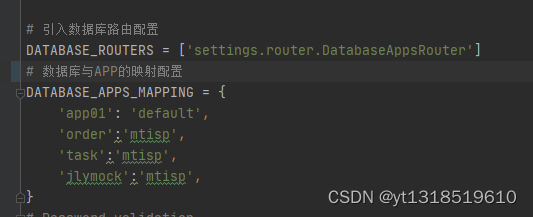1.在项目根目录下新建文件夹settings(名字随意),然后在文件夹下新建router.py文件,添加代码如下(代码不用修改)
from django.conf import settings
DATABASE_MAPPING = settings.DATABASE_APPS_MAPPING
class DatabaseAppsRouter(object):
"""
A router to control all database operations on models for different
databases.
In case an app is not set in settings.DATABASE_APPS_MAPPING, the router
will fallback to the `default` database.
Settings example:
DATABASE_APPS_MAPPING = {'app1': 'db1', 'app2': 'db2'}
"""
def db_for_read(self, model, **hints):
""""Point all read operations to the specific database."""
if model._meta.app_label in DATABASE_MAPPING:
return DATABASE_MAPPING[model._meta.app_label]
return None
def db_for_write(self, model, **hints):
"""Point all write operations to the specific database."""
if model._meta.app_label in DATABASE_MAPPING:
return DATABASE_MAPPING[model._meta.app_label]
return None
def allow_relation(self, obj1, obj2, **hints):
"""Allow any relation between apps that use the same database."""
db_obj1 = DATABASE_MAPPING.get(obj1._meta.app_label)
db_obj2 = DATABASE_MAPPING.get(obj2._meta.app_label)
if db_obj1 and db_obj2:
if db_obj1 == db_obj2:
return True
else:
return False
return None
def allow_syncdb(self, db, model):
"""Make sure that apps only appear in the related database."""
if db in DATABASE_MAPPING.values():
return DATABASE_MAPPING.get(model._meta.app_label) == db
elif model._meta.app_label in DATABASE_MAPPING:
return False
return None
def allow_migrate(self, db, app_label, model=None, **hints):
"""
Make sure the auth app only appears in the 'auth_db'
database.
"""
if db in DATABASE_MAPPING.values():
return DATABASE_MAPPING.get(app_label) == db
elif app_label in DATABASE_MAPPING:
return False
return None
2.在项目的settings.py文件中增加对应数据库配置

3.在项目的settings.py文件中引入数据库路由配置,settings.router.DatabaseAppsRouter为第一步创建的类的路径
DATABASE_ROUTERS = ['settings.router.DatabaseAppsRouter']
4.在项目的settings.py文件中增加数据库与APP的映射配置,支持每个APP都使用不同的数据库
格式为: 'app名称': '数据库名称',
DATABASE_APPS_MAPPING = {
'app01': 'default',
'app02': 'mtisp',
????'app03': 'mtisp',
}

?
?